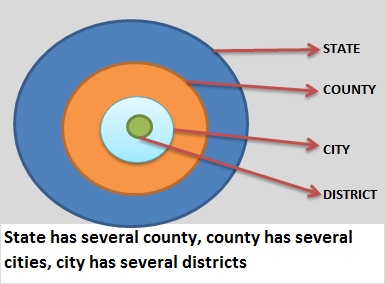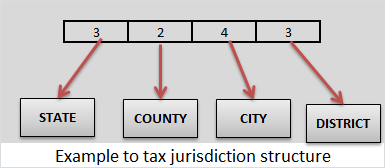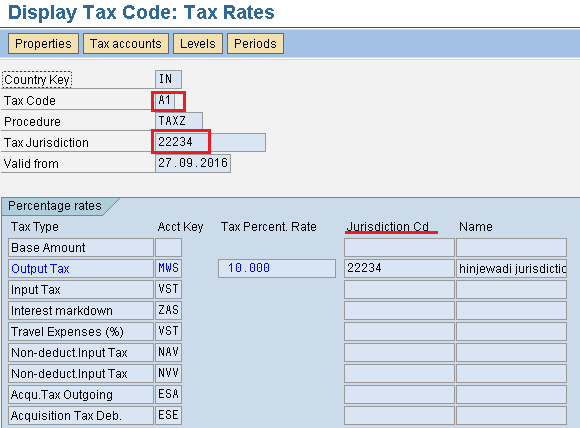As we know, each country has a tax procedure. Tax procedure is a list of tax condition types and each condition type represents a type of tax.
Tax percentage against each tax condition type is maintained in tax code.
Why is the need for jurisdiction code?
In USA, tax authority is different for each area and tax authority decides tax percentage in that area. Hence the tax percentage applicable on a business transaction depends upon which area the transaction belongs to (tax to be paid to which tax authority).
Sap handles this requirement by using concept of jurisdiction code. Each tax authority is created as a jurisdiction code in sap.
jurisdiction structure
Jurisdiction code is to identify which area or which tax authority is involved in business transaction hence by looking at tax jurisdiction code you should be able to identify the area.
Hence jurisdiction is created in such a way that it answers below
Which state?
Which county?
Which city?
Which district?
Jurisdiction code is composed of codes which represent state/ county/ city/ district.


3 alphanumeric digits representing state
2 alphanumeric digits representing county
4 alphanumeric digits representing city
3 alphanumeric digits representing district
Tax jurisdiction code = (State + county + city + district)
Defining how many characters which represent state, how many characters represent county, how many characters represent city and how many characters represent district is known as jurisdiction structure.
Before creating tax jurisdiction code, tax jurisdiction structure has to be defined in the system.
How is tax percentage maintained?
Tax percentage against tax condition types is maintained in combination of tax code and tax jurisdiction.

In a business transaction, how system decides jurisdiction code?
Entered document has company code. Company code leads to country, country leads to tax procedure. Procedure has condition types but tax percentage for condition types is maintained in combination of tax code and jurisdiction code.
When document is entered, tax code is input but jurisdiction code is not input. So how does system identify which jurisdiction code to use?
System fetches tax jurisdiction code from
Involved parties in the transaction like vendor master, customer master
Objects involved in transaction like internal order master, cost center master, profit center master.
Note: Tax jurisdiction code is maintained in vendor master, customer master, internal order master, cost center master, profit center master etc.
GL ACCOUNTING
- What is SAP FICO ?What business requirement is fulfilled in this module?
- What is enterprise structure in sap fico?
- What is GL account? What is account group? What is operational chart of accounts?
- What is the need of country chart of account or alternate chart of account? How country chart of account helps fulfill a business requirement?
- What is the need for group chart of account? How group chart of account helps in consolidation of financial data?
- What is non leading ledger in sap fico?
- What is company code global settings? What global parameter is assigned to company code?
- What is fiscal year variant? Why fiscal year variant is assigned to company code?
- What is posting period variant? Why posting period variant is assigned to company code?
- What is field status variant? What is field status group?
- What is document type in sap? Explain the purpose of document type?
- Document date vs Posting date vs Entry date vs Translation date. Explain
- What is posting key? what is the use of posting key?
- Document header & line items capture information of business transaction.
- Everything about currency & exchange rate in sap.
- Foreign currency valuation in sap. Explain with example
- Retained earnings account helps in year end balance carry forward. Explain
- What is the significance of tolerance groups in sap?
- What parameters are maintained in GL master and how does it impact in document posting?
ACCOUNTS PAYABLE
- What is meant by accounts payable in sap?
- Understanding procure to pay (PTP) cycle and accounting document at each step.
- Understanding MM FI integration in very simple terms.
- Purchase order price determination in SAP. Explained in very simple words.
- House bank, Bank key, Account ID in SAP
- What configuration (FBZP) needed for executing F110 in sap ?
ACCOUNTS RECEIVABLE
- How sap overcomes challenges in accounts receivable process?
- What is customer reconciliation account?
- Understanding order to cash cycle in sap.
- Understanding SD FI integration in very simple terms.
- What is lock box? How lockbox helps in collection from customers?
TAX ACCOUNTING
- How sap helps in tax accounting?
- Tax configuration in sap: Tax procedure, Tax code & Tax jurisdiction code
- Concept of tax jurisdiction code & tax jurisdiction structure
- Significance of “Tax category & Posting without tax allowed” in GL master.
- Tax base amount and Discount base amount
- Assigning tax code V0 & A0 for non taxable transaction?
- Deductible input tax vs non deductible input tax
WITHHOLDING TAX
- Withholding tax in sap explained with example.
- How sap overcomes challenges in managing withholding tax?
- Withholding at the time of invoice or payment
- Withholding tax configuration in sap
- Business place & Section code in sap
- Withholding tax certificate numbering in sap
- Withholding tax report for filling tax returns
ASSET ACCOUNTING
- How sap helps in asset accounting?
- What is meant by asset accounting?
- What is the use of asset class?
- What is the use of depreciation key in asset accounting?
- Depreciation area and Chart of depreciation in sap.
- Derived depreciation area VS real depreciation area?
- Understanding asset accounting configuration needed in sap
- GL account determination for posting asset transaction
- Asset transaction and corresponding accounting document?
- How depreciation is posted in sap?
SAP CONTROLLING